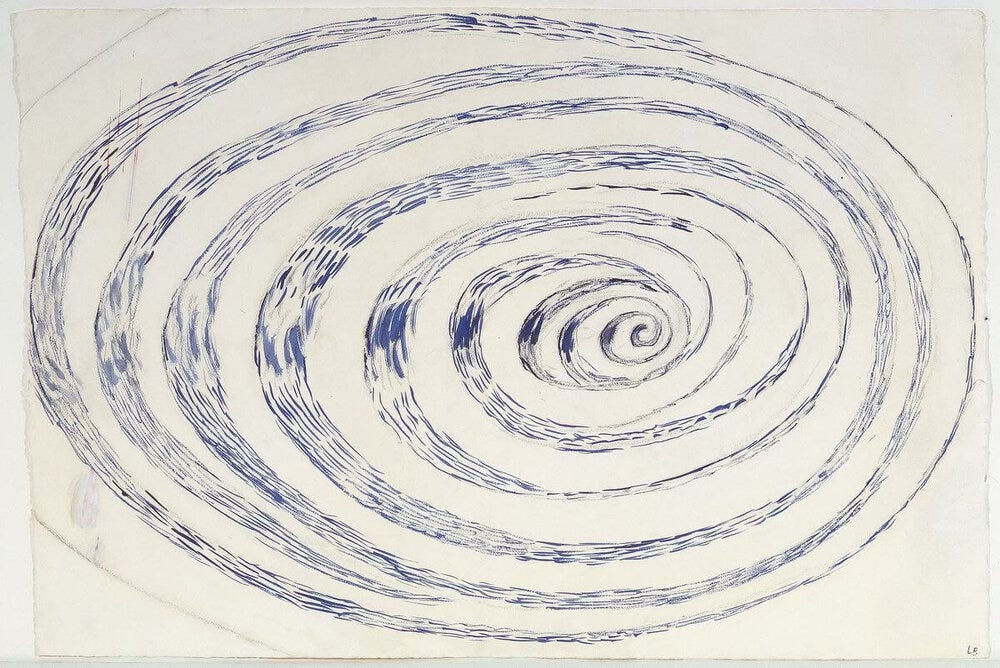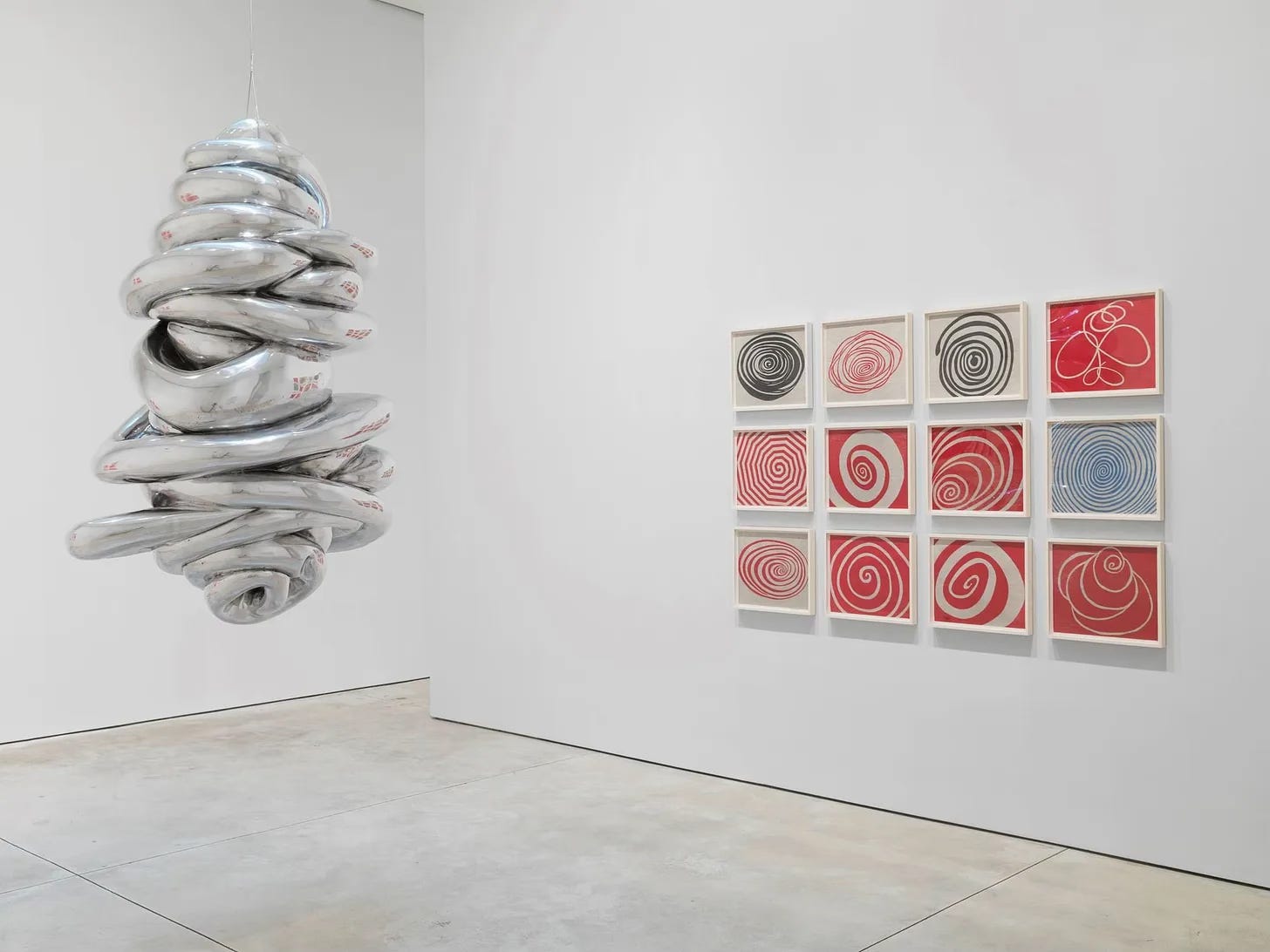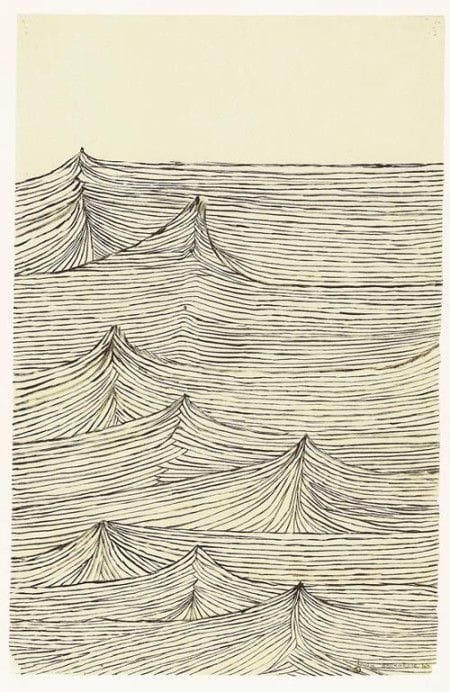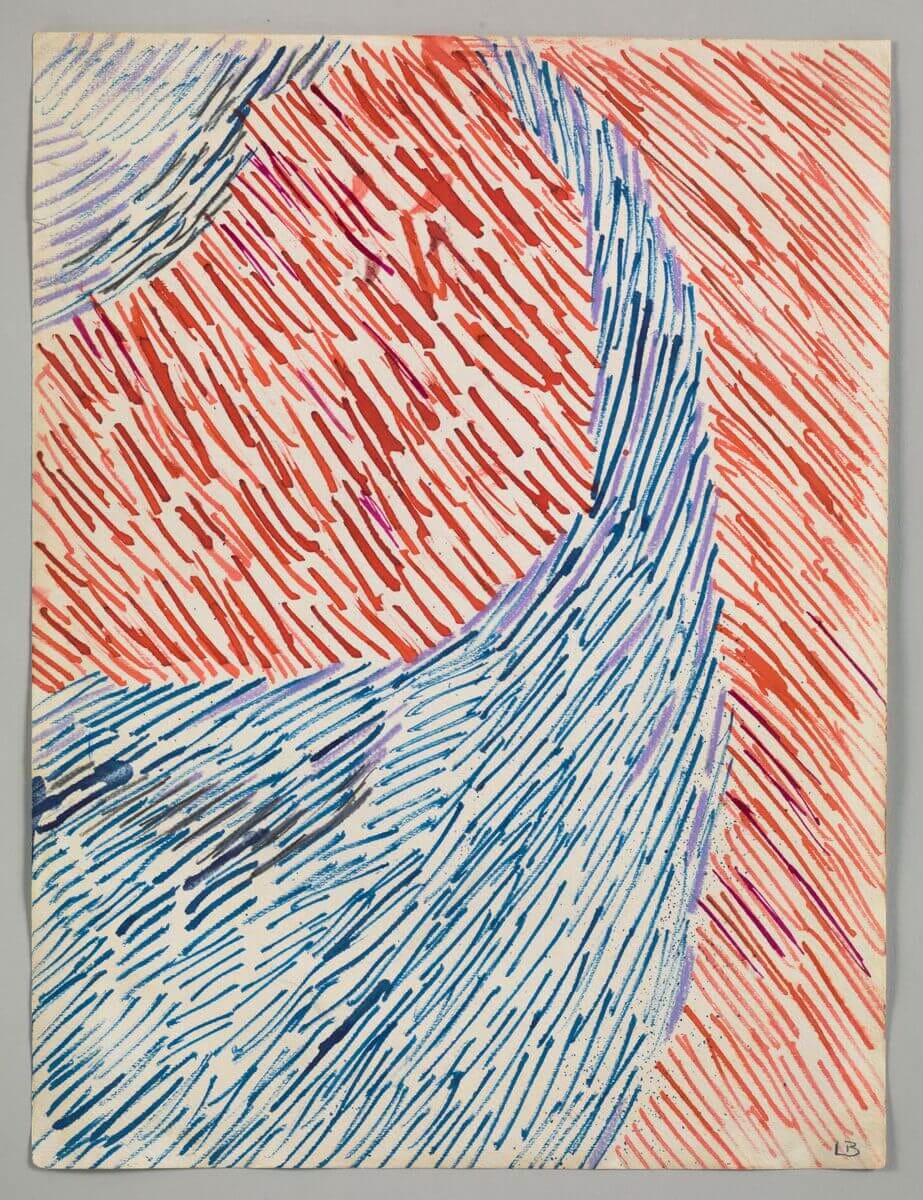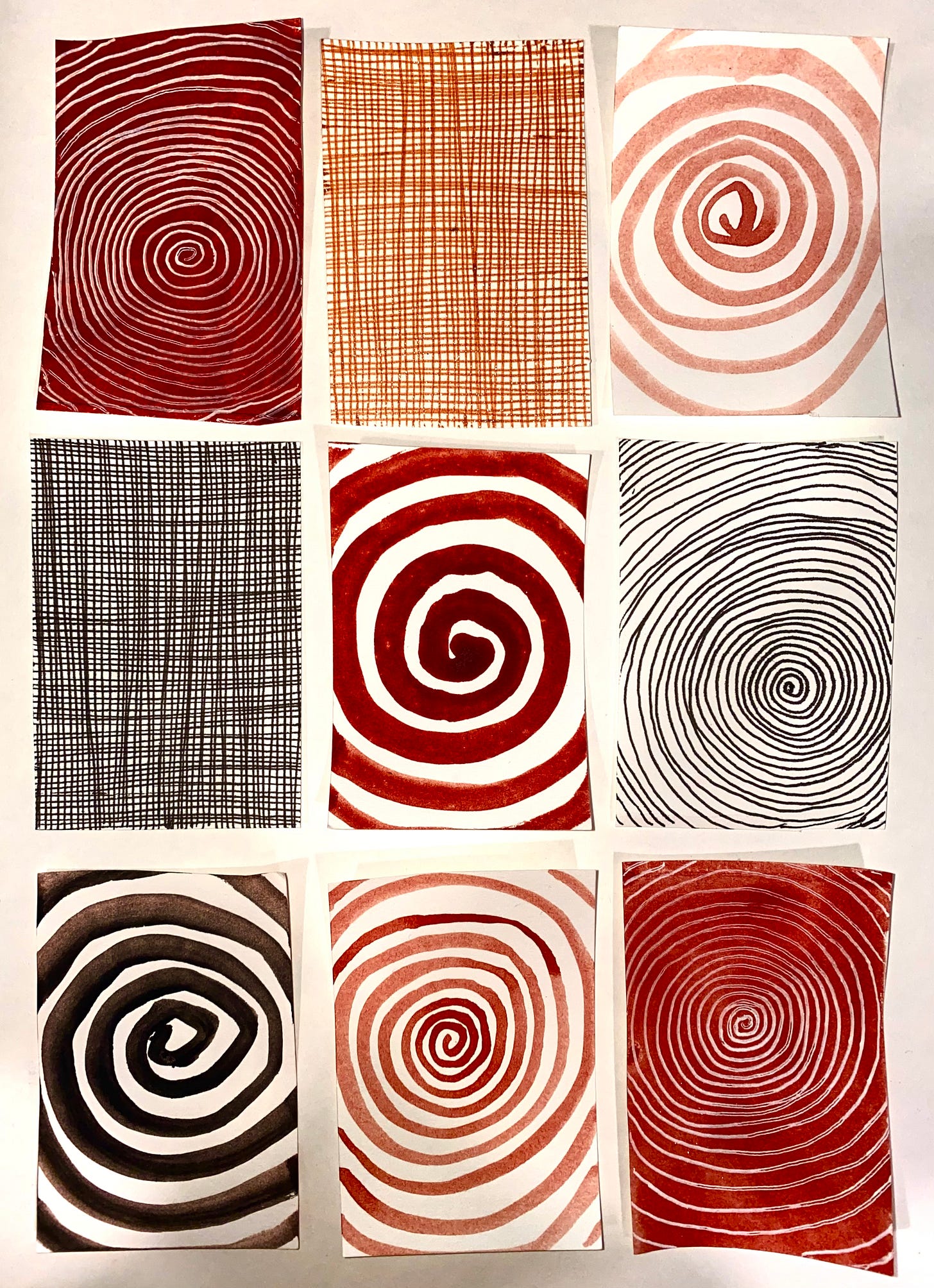Emotional Suites
Working out big feelings through repetition, abstraction and constraints.
Hello my dear GUTsters,
So happy you’re here. Last week’s GUT was a big one. It’s clear many of us - maybe all of us - are holding grief over the ongoing devastation in Gaza, and other places around the world, too. It was heartening to me, personally, to see everyone’s engagement with last week’s spotlight on Palestinian artists Samia Halaby, Kamal Boullata, and Hazem Harb. I was deeply moved by your artwork, your comments and the conversations you are having with one another in the chat, GUT peeps. I appreciate how you engaged with me and each other with an open heart, and for looking and listening to one another and the world. Thank you for making the effort to draw in these artists shoes.
The artwork of artists Halaby, Boullata, and Harb involved elements of repetition and abstraction. While the art was not representational, it all suggested themes of identity and place - geographic, cultural and emotional - and all the deep feelings that come along with that. This week I’m taking you further down the road of repetition and abstraction, and all those deep feelings.
“Art is a guarantee of sanity" - Louise Bourgeois
Drawing helps us identify and process our feelings, reduce anxiety, increase curiosity and wonder, feel less isolated, and stay connected with each other and the world around us. So while we spend a lot of time in DrawTogether looking outward towards one another and the world around us, it’s just as important to turn our eyes inward and process the all those big feelings and thoughts we hold inside. There is no better artist to help us do that than Louise Bourgeois.
This week we will use the theme of abstraction and repetition to create “suites” of drawings that provide “psychological release” and process those big feelings we’ve all been having lately. So get out ALLLL your mediums, friends. Our drawings this week might be messy, will definitely be mini, and it’s gonna feel (and look) great.
Suite Emotion
What’s a Suite?
In music, a suite is a “set of musical pieces considered as one composition.” Think: The Nutcracker. It's similar in visual art. In visual art, a suite is a set of unique but connected artworks that constitute one whole artwork. Often the visual language, color palette, subject matter and compositional elements in a suite are similar. They are usually meant to be displayed together. So a suite is like a series, except each piece is actually dependent on each other and together they constitute the whole finished piece.
Example: Take the 30 drawings we did together in January. Are they a suite or a series? Well, that’s up to you, but they can’t be both. Let’s say you were going to do an exhibition of them. If you wanted to consider each drawing you did as a unique effort, then it might make sense to display one on its own. So that would be a series. If you consider all 30 one big, epic artistic effort, then it would only make sense to display them together. And that would be a suite. Make sense?
As always, no rules in art. Except the ones you want to define for yourself. YOU get to decide the context for your work. And if there was ever an artist who refuted rules and defined her own context, it was today’s inspiration: Louise Bourgeois.
Louise Bourgeois
“Drawing is the most basic psychological release.” - Louise Bourgeois
You may know Louise from her giant spider sculptures (inspired by her mother, a weaver!) Maybe you know her hanging body sculptures or many boob forms. (So. Many. Boob. Forms.) Or maybe you don’t know her at all! Regardless, today’s jumping off point for our own suite drawings are the drawings of artist Louise Bourgeois, who died in 2010 at 98 years old. Louise drew throughout her life.
Louise was born in Paris. Her parents were tapestry restorers, and she learned to work with her hands at an early age. She showed a real knack for drawing when she was young and pursed it with gusto - drawing gave her a role in her family and she got praise for it. Maybe because of her exposure to the construction, destruction and restoration of objects through her parents work, she had a strong curiosity about how things are made, their structure and anatomy, and kept notebooks filled with detailed sketches and notes. She was sharp and a quick study.
In art school, Louise studied the figure and patterns and design, then in her 30s - when she’d left home and moved to New York - shifted her practice from observation of the outside to observation of the inside.
“Happy people have no stories.” - Louise Bourgeois
Fact is, Louise’s family home growing up had not been great, and she carried the trauma of that house with her. Her father had an ongoing affair with her tutor, her parent’s marriage was a mess, she felt betrayed by her father, her relationship with her challenging mother was fraught and complicated… All that resulted in terrible anxiety and emotional struggles. At some point she turned away from looking outwards for inspiration and instead shifted inwards and started drawing abstract emotional and psychological landscapes. Her art became her coping mechanism. Drawing became her “survival mode.” And she began making the work that we know her for today.
“The modern artist is caught in a dilemma in that he considers art a psychological release and at the same time wants to have an audience.” - Louise Bourgeois
Sometimes Louise would go years without drawing, but she’d be writing nonstop. Sometimes the opposite. She kept journals and drew and wrote on loose leaf papers. She had terrible insomnia and would often draw at night. Her long-time assistant would arrive at her house at 10am to find fresh drawings scattered on the table and floor. When Louise sat down to draw she did not know what would happen. While she called art making a “voyage without a destination,” she did have recurring themes, like waves, hair, and spirals.
“The spiral is an attempt at controlling the chaos.”
If you’ve been with DrawTogether for more than a minute, you’ve probably heard me talk about spirals before. Louise spirals… Lynda Barry spirals… Robert Smithson spirals. So many artists have made spirals a theme in their work. Not only are they pervasive throughout nature and evident in our universe from the inside out, they are incredibly relaxing to draw. They are so relaxing that I dedicated an entire DrawTogether kids video to the DrawTogether heart spiral. Drawing a spiral helps us calm down, get centered, focus and be present in a minute.
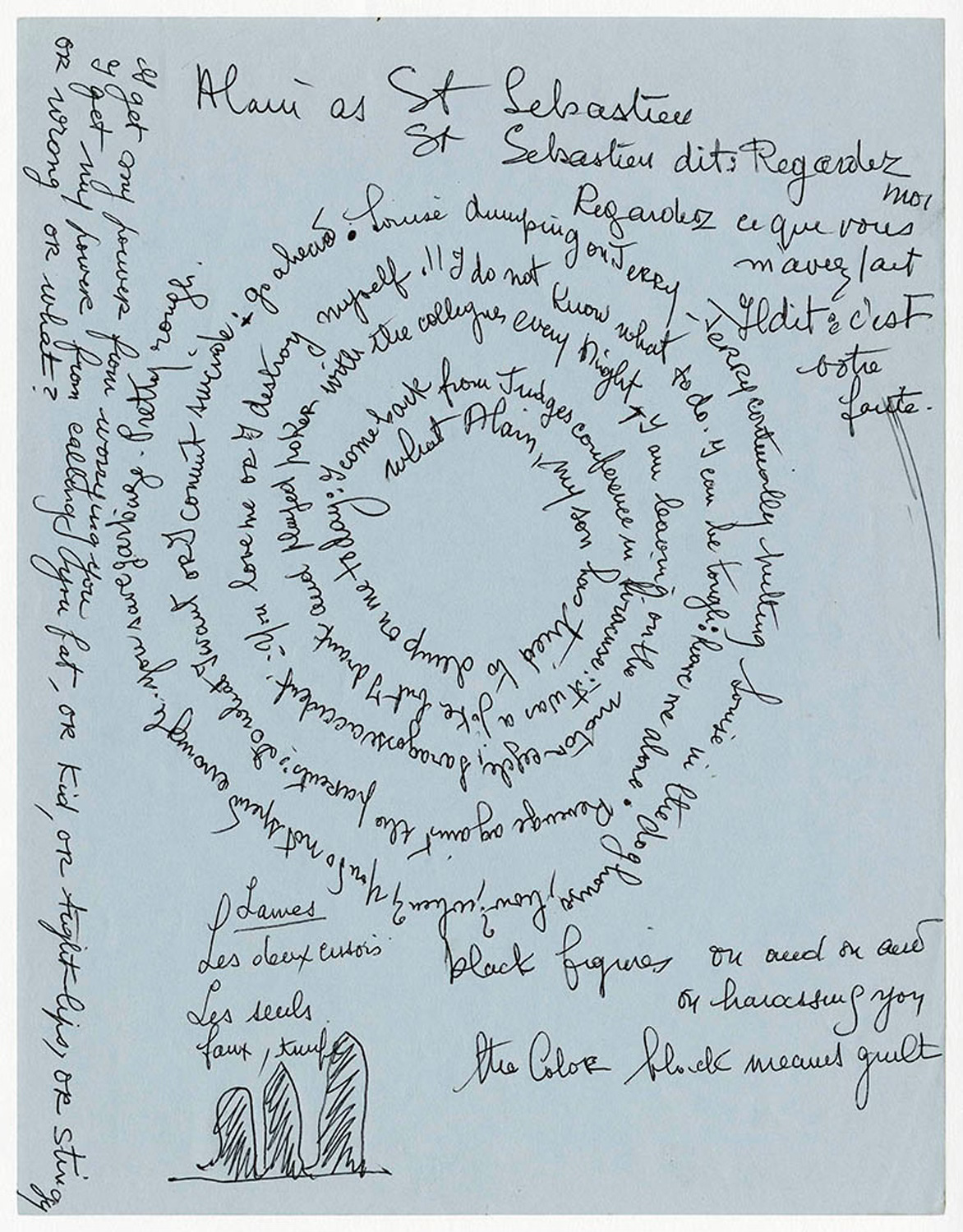
Louise said the movement of drawing a spiral outwards creates an experience of “giving, and giving up control, trust and positive energy.” While drawing a spiral inwards experienced “a tightening, a retreating, a compacting to the point of disappearance.”
BUT WAIT. WE ARE NOT HERE FOR SPIRALS. I’m just spiral-obsessed. Let’s move on.
Spirals were only one Louise’s recurring motifs. She also focused on drawing patterns using crosshatching (similar to the Agnes Martin grids we’ve drawn), lines and waves.
In 2005, at the age of 93, Louise used the motifs of the spiral, cross-hatching, lines and waves to create suite of 60 double sided drawings. The suite is titled “Je T’aime.” Here it is in full:

Here is another shot of it installed in a museum in Maryland where you can get a sense of the scale. Considering the size and detail of the drawings, she must have spent at least several days on each.

So what creative constraints did Louise use in the drawings in this suite? What makes the 60 drawings in the suite visually cohesive?
Each drawing is identical in size (9.5 x 8 inches).
The drawings are all abstract, and they contain the same repeated themes: spirals, crosshatching, or an undulating line.
The mediums vary between charcoal, ink (looks like some ballpoint to me), pencil, and paint (gouache), but the color pallet is limited to blue, black, red and the white of the paper.
Also, the entire surface of every drawing is filled, from edge to edge (full bleed, as they say in design.) When those fully drawn pieces are displayed together like this, as a suite, it looks a lot like a quilt. (Something we will explore through drawing later!) Which brings me back full circle to her upbringing… creating this quilt, and the repetitive line making she sues, how much that is like weaving or sticking… makes me think back to family’s tapestry business, and how growing up surrounded by that process when she was 9 had such a huge impact on her work when she was 95.
This is one of the fun things about learning about an artist life and looking at their art, and connecting it to our own live and creativity. We can find stories and meaning beyond the surface of the art we see in the world (and EVERYTHING WE SEE IN THE WORLD), make meaning and stories of it, and make connections to our own lives and stories. Then we use our pens and our brushes to try it ourselves, and bring into our bodies bones, and it becomes a part of our art and of us.
Which is another way of saying: Enough blabbing. Let’s DRAW.
Assignment: Drawing Emotional Suites
This week we are creating our own abstract mini-suites. We’ll use constraints similar to what Louise used to draw her suite of images to help us focus on process rather than outcome. Don’t forget to share your work in the chat, and check out the community and conversation there, even if you don’t feel like sharing your drawings. I feel like we could all use a hug this week, and there are plenty there waiting for you.
Okay, here’s what you’ll need:



